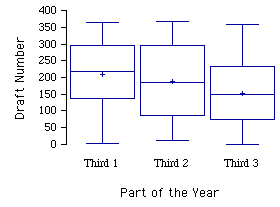
In 1969 the war in Vietnam was at its height. An agency called the Selective Service was charged with finding a fair procedure to determine which young men would be conscripted ("drafted") into the U.S. military. The procedure was supposed to be fair in the sense of not favoring any culturally or economically defined subgroup of American men. It was decided that choosing "draftees" solely on the basis of a person’s birth date would be fair. A birthday lottery was thus devised. Pieces of paper representing the 366 days of the year (including February 29) were placed in plastic capsules, poured into a rotating drum, and then selected one at a time. The lower the draft number, the sooner the person would be drafted. Men with high enough numbers were not drafted at all.
The first number selected was 258, which meant that someone born on the 258th day of the year (September 14th) would be among the first to be drafted. The second number was 115, so someone born on the 115th day (April 24th) was among the second group to be drafted. All 366 birth dates were assigned draft numbers in this way.
To crate box plots, we divided the 366 days of the year into thirds.
The first third goes from January 1 to May 1, the second from May 2 to August
31, and the last from September 1 to December 31. The three groups of birth
dates yield three groups of draft numbers. The draft number for each birthday
is the order it was picked in the drawing. The figure below contains box plots
of the three sets of draft numbers. As you can see, people born later in the
year tended to have lower draft numbers.
